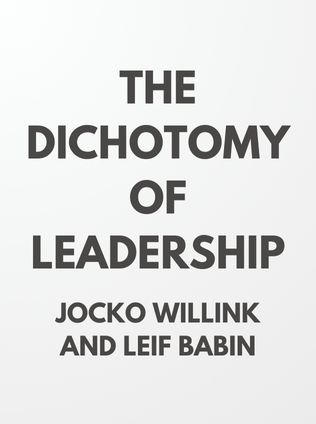
The Dichotomy of Leadership
Balancing the Challenges of Extreme Ownership to Lead and Win
By Jocko Willink and Leif Babin
Published 09/2018
About the Author
Jocko Willink and Leif Babin, both former Navy SEAL commanders, are celebrated for their profound understanding of leadership. Their experiences in some of the most perilous environments on earth have shaped their approach to leadership. They learned that leading a team to success requires not just courage and determination but also a deep understanding of human nature and the ability to balance competing demands. Their experiences on the battlefield have informed their leadership philosophy, which they now share with the world through their books and their leadership consultancy, Echelon Front.
Willink and Babin are more than just authors; they are practitioners of leadership who have tested their ideas in the crucible of combat. They understand that leadership is not about issuing orders from a position of authority but about inspiring others to achieve their full potential. Their approach to leadership is deeply rooted in their belief in "Extreme Ownership," the idea that leaders must take full responsibility for their team's success or failure. This philosophy is the foundation of all their teachings and is the guiding principle behind their second book, The Dichotomy of Leadership.
Main Idea
Leadership is a complex and often contradictory endeavor. In The Dichotomy of Leadership, Willink and Babin explore the idea that every quality of a good leader can become a weakness if taken to the extreme. Courage can turn into recklessness, discipline into rigidity, and empathy into emotional paralysis. The key to effective leadership is finding the right balance between these extremes. Willink and Babin argue that leaders must navigate these dichotomies to achieve success, both for themselves and for their teams.
The authors introduce the concept of "dichotomies" in leadership, where opposing forces must be balanced to lead effectively. These dichotomies are not binary choices but rather a spectrum where the right answer lies in the middle. Leaders must be adaptable, knowing when to push forward aggressively and when to hold back, when to assert their authority and when to listen to others. This balancing act is at the heart of leadership, and it is what separates good leaders from great ones.
Table of Contents
- The Philosophical Roots of the Dichotomy of Leadership
- Dichotomy #1: Care About Each Individual, but Make Sacrifices for the Group
- Dichotomy #2: Take Responsibility for Your Team, but Don’t Do Everything
- Dichotomy #3: Maintain High Standards, but Don’t Push Too Hard
- Dichotomy #4: Defer to Others, but Trust Yourself
- Dichotomy #5: Rush Forward, but Be Careful
The Philosophical Roots of the Dichotomy of Leadership
The concept of balancing extremes is deeply embedded in various philosophical traditions, and Willink and Babin's leadership philosophy echoes these ancient principles. The idea that virtue lies in the balance between two extremes, known as the "golden mean," was introduced by the Greek philosopher Aristotle. Aristotle believed that every virtue is a balance between deficiency and excess. For example, courage is the balance between recklessness and cowardice. This idea has been influential in shaping ethical thought and is central to Willink and Babin's approach to leadership.
In Confucianism, the "Doctrine of the Mean" emphasizes the importance of moderation in all things. This doctrine, written by Zisi, the grandson of Confucius, teaches that the best course of action is always the one that lies between extremes. Similarly, Buddhism's "Middle Way" promotes a path of moderation between indulgence and self-denial. These ancient philosophies share a common theme: the idea that balance is the key to living a virtuous and successful life.
Willink and Babin apply this timeless wisdom to the modern challenges of leadership. They argue that effective leaders must find the balance between competing demands and avoid the pitfalls of extreme behavior. Just as Aristotle's golden mean provides a framework for ethical decision-making, the dichotomies of leadership provide a framework for making wise leadership decisions. By grounding their leadership philosophy in these ancient principles, Willink and Babin offer a timeless guide for modern leaders.
Dichotomy #1: Care About Each Individual, but Make Sacrifices for the Group
One of the most challenging aspects of leadership is balancing the needs of individual team members with the needs of the group. Willink and Babin emphasize that a leader must care deeply for each member of the team, building strong bonds of trust and mutual respect. This deep connection is essential for creating a cohesive and motivated team. When team members feel that their leader genuinely cares about their well-being, they are more likely to go above and beyond to achieve the mission.
Sign up for FREE and get access to 1,400+ books summaries.
You May Also Like
The Subtle Art of Not Giving a F*ck
A Counterintuitive Approach to Living a Good Life
By Mark MansonRich Dad Poor Dad
What the Rich Teach Their Kids About Money - That the Poor and Middle Class Do Not!
By Robert T. KiyosakiHow To Win Friends and Influence People
The All-Time Classic Manual Of People Skills
By Dale CarnegieQuiet: The Power of Introverts
The Power of Introverts in a World That Can't Stop Talking
By Susan Cain



















